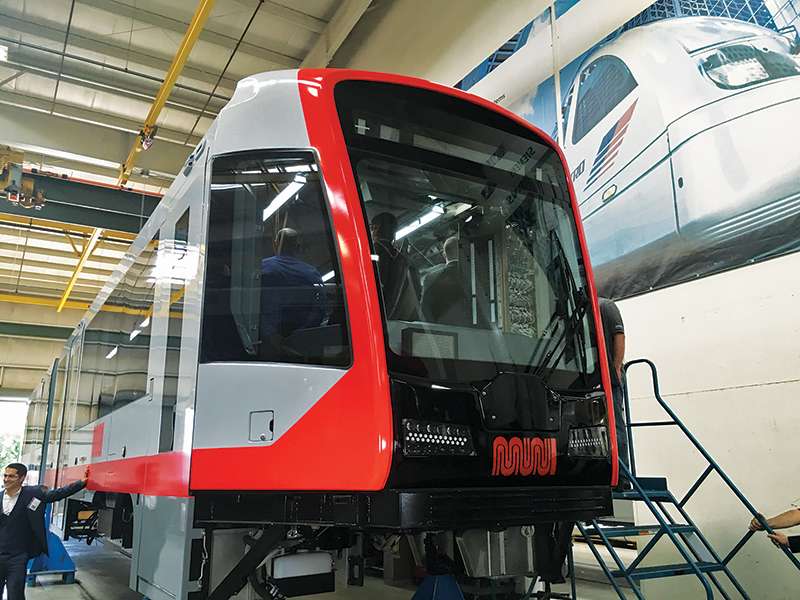
Born out of Assembly Bill 32 (Pavley) in 2006, cap-and-trade is a statewide effort to lower greenhouse gas emissions. It generates revenue by collecting permit fees from businesses that produce emissions above a certain cap. However, revenue has been declining due to doubts about the program’s future, which is threatened by a California Chamber of Commerce lawsuit alleging that the fees constitute an illegal tax. There are also questions about whether the cap on emissions is rigorous enough.
“There are a lot of ups and downs in the revenue-raising because there is uncertainty,” said Eddie Ahn, executive director at Brightline Defense Project, a policy advocacy nonprofit based in San Francisco.
About 60 percent of cap-and-trade funds filter into transportation programs. The biggest of these is high-speed rail, which is expected to contribute funding to the Bay Area for electrification of the Caltrain system, since the two railways will eventually share the same Peninsula corridor.
While that allocation has yet to be made, a separate cap-and-trade program has already contributed $20 million to Caltrain for purchasing electric trains to replace its diesel locomotives. This program, which focuses on capital improvements, has provided a total of $152.3 million to the Bay Area, including $86 million to the San Francisco Municipal Transportation Agency (SFMTA) for buying 10 light rail vehicles and meeting ridership demand.
Two other transportation programs have provided the region with cap-and-trade funding; one has allocated $162.2 million for financing housing (including low-income units) near public transit, and the other has allocated $37.3 million to transportation agencies for reducing operations emissions.
Each cap-and-trade transportation program has its own funding criteria, but CES factors into all of them except high-speed rail. The first version of the mapping tool was produced by the California Environmental Protection Agency (CalEPA) in April of 2013. In September, the agency released the draft for CES 3.0, which is tied to 20 indicators to score the state’s 8,000 census tracts. The Bay Area has 29 fewer census tracts in CES 3.0 compared to the previous version, representing a 34 percent drop.
As currently drafted, CES 3.0 creates potential for low-income communities to be screened out when they score high in certain variables, but not high enough in others to meet the DACs definition, according to letters that MTC and other local transit officials submitted during the recent public comment period.
For example, some census tracts in Oakland, Antioch, and Concord are beset by unemployment, asthma, diesel particulate matter, and poverty, but CES 3.0 omits them because their scores for hazardous waste, solid waste, and impaired water bodies aren’t high enough.
“You can’t qualify as a disadvantaged community unless you are heavily polluted and socioeconomically disadvantaged,” said Rebecca Long, MTC’s government relations manager.
To be fair, not all areas saw drops. San Francisco added four census tracts in Bayview-Hunters Point, one of the city’s most economically depressed districts. But to bring greater parity to CES, transit officials suggest more vetting to better reflect DAC attributes statewide. Some even provided recommendations to weight applications for specific programs according to pollutants relevant to the funding program.
“We’re urging a reconsideration of the current definition of disadvantaged communities,” said Jayme Ackemann, director of marketing and communications at the San Mateo County Transit District.
Long also advised a cost-of-living adjustment. When added, it shows the Bay Area has 17 percent of the state’s households living in poverty, compared to less than 3 percent statewide under CES 3.0.
“Right now, our advocacy effort is not about dismantling CES as a tool, but ensuring it’s as inclusive as possible,” Long said.
The state’s Office of Environmental Health Hazard Assessment, which has been partnering with CalEPA in developing the mapping tool since the beginning, is looking closely at these and other issues prior to the finalization of CES 3.0. Sam Delson, the office’s deputy director for external and legislative affairs, explained that “part of this includes evaluating whether the available data is of sufficient quality to provide meaningful results at the census tract level.”
Addressing CES methodology feels even more urgent for some Bay Area transit operators when they take into account new legislation. Passed this fall, Assembly Bill 1550 (Gomez) stipulates 25 percent of cap-and-trade funds be invested within DACs, instead of the previous requirement that 25 percent of funds simply benefit DACs. AB 1550 is one of four cap-and-trade bills negotiated as a package this fall. Specifics of each bill vary, but they do intend to help fund state and local programs by cutting emissions and are affected by the much-debated DAC definition.
“We’re still working through those implications,” said SFMTA Chief Spokesperson Paul Rose about AB 1550.
For example, the most congested points on SFMTA bus and rail routes that serve DACs are typically located elsewhere on those routes. That means benefits for residents in DACs can often be achieved by investing in other areas within SFMTA’s service zone.
Overall, it’s unclear if legislative changes and DAC definition challenges will prevent cap-and-trade from functioning the way it’s intended over the long term. Advocates point out that identifying DACs is a nuanced process, and that CES has contributed a framework that has advanced large-scale transportation planning goals.
Cap-and-trade “has given incentive to the kinds of projects we know reduce vehicle miles traveled, improve safety, and provide folks in the Bay Area options for housing,” said Joshua Stark, state policy director at TransForm, an advocacy group.
However, it’s important that cap-and-trade is not assessed in isolation, but rather as part of the larger regulatory context that also includes other state climate change policies aimed at energy renewables and low-carbon fuel standards, said Alice Kaswan, professor at the University of San Francisco School of Law.
“You can’t evaluate [cap-and-trade] out of context,” she said.
The final version of CalEnviroScreen 3.0 is due for release prior to the end of 2016.
Cecily O’Connor covers transportation for the Monitor.